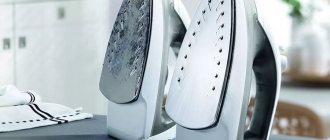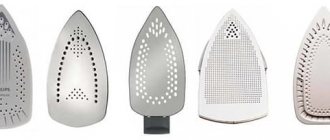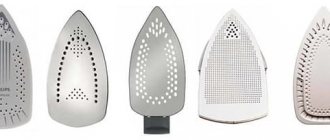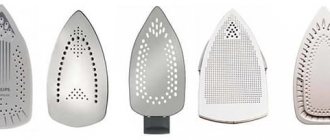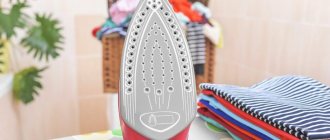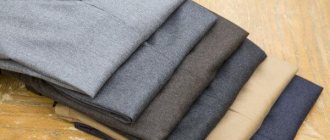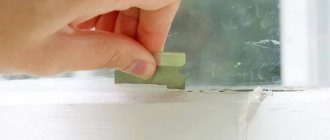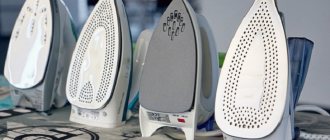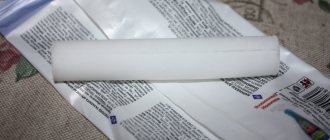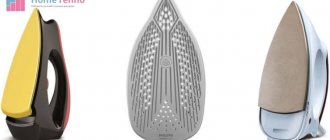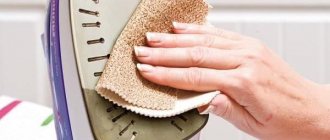How to clean an iron from burnt marks at home: traditional methods
Toothpaste Vinegar Citric acid and ammonia Soda Nail polish remover Hydrogen peroxide Salt Paraffin candle
Purchased products for cleaning carbon deposits on the soleplate of an iron
Melamine sponge Special liquid products for cleaning the soleplate of the iron Cleaning mat Pencil for removing carbon deposits
If the sole of the iron has turned black and it is no longer possible to iron with it, do not rush to throw away the equipment. The appearance of carbon deposits on the surface is inevitable. For example, the sole may turn black when a patterned item is ironed with a heated iron without gauze or a special mesh. Also, the surface becomes dark when the iron is forgotten to be turned off, and it burns to some fabric. Tap water, in turn, causes rust to appear on the sole, and scale inside it.
The consequences of such errors are easy to eliminate. In this article, you will learn about different ways to remove carbon deposits from the sole of an iron - both folk methods and using commercial products.
Types of coatings
Typically, the soleplate of the iron is made of aluminum or stainless steel. For better glide, a special coating is applied to its surface, which can be different:
- Titanium. Its advantages are durability and strength.
- Ceramic or glass ceramic. This sole glides easily over things and is quickly cleaned, but if handled carelessly, chips and scratches may occur.
- Teflon. The material is resistant to synthetic fabrics even when overheated.
- Enamel. It is difficult to scratch, but may crack over time.
The choice of cleaning method depends on the type of coating. The main task is to completely clean the device from dirt and not scratch the surface.
What do we need?
Ceramic is a very fragile material that can be easily scratched by accidentally ironing metal buttons or zippers on clothing.
You need to clean the iron extremely carefully , using soft rags, sponges and detergents without abrasive particles.
There are many special chemicals that will help make the soleplate of the iron perfectly clean; home remedies are also suitable for removing stains: lemon, vinegar and others.
8 recipes on how to clean a ceramic stove from carbon deposits are presented here.
Methods for ceramics and Teflon
The main condition is not to use any abrasives. Even the smallest and softest particles will leave scratches.
Cleaning Pencil
The cleaning rod contains urea and organic acids. Some manufacturers add aromatic fragrances.
When it comes into contact with a heated sole, the pencil begins to melt. The acids contained in it, under the influence of high temperature, react with carbon deposits and dissolve it.
Procedure:
- open a window in the room, providing an influx of fresh air, since when a pencil comes into contact with a hot surface, a pungent odor is released;
- prepare the area, cover it with old newspapers or cloth, which can then be thrown away;
- heat the iron well, but do not heat it, and unplug it;
- take a pencil and, pressing gently, clean the contaminated areas;
- remove the remains of the melted rod, wipe the sole with a piece of damp cloth.
The final stage is to clean the steam holes with cotton swabs.
Table vinegar
You can clean the ceramic or Teflon soleplate of your iron with vinegar. Here's how to proceed:
- prepare a weakly concentrated acid solution, take 2 tbsp per 200 ml of boiled water. l. 9% vinegar;
- heat the iron slightly;
- take a piece of clean soft cloth, soak it in the prepared solution, and clean off the dirt.
- Wipe the sole with a wet cloth and remove any remaining moisture with a dry cloth.
Advice! Old, stubborn carbon deposits can be cleaned with undiluted 9% vinegar using a rough cloth, such as a waffle towel.
Hydrogen peroxide
Regular 3% peroxide will help clean a ceramic or Teflon iron from minor burnt marks. To do this, you need to heat the device and use a cotton pad soaked in the solution to treat problem areas.
Advice! If the iron cools down, it needs to be reheated again, so the deposits will come off easier.
An analogue of peroxide is hydroperite tablets. You need to dissolve 2 tablets in 100 ml of water, and use the resulting solution to clean the burnt electrical appliance. The active ingredients of the prepared product are hydrogen peroxide and urea. The product is more concentrated and effective compared to regular peroxide.
Ammonia solution
Regular ammonia can be successfully used to clean the surface of the iron. There are several ways:
- Moisten a cotton pad with ammonia and wipe off the resulting residue. Change discs when they become dirty. There is no need to heat the iron.
- Combine ammonia and 9% vinegar in equal proportions, 1 tbsp. l. and thoroughly clean the ironing surface.
- Take 1 tbsp. l. alcohol, add 5-6 drops of fresh lemon juice to it. Wipe off any stains, then clean the sole with a clean, damp cloth.
Advice! Ammonia has a pungent odor, so the procedure should be carried out in a room with an open window or on the balcony.
Laundry soap
You can clean the iron from small deposits with laundry soap. It has a high content of fatty acids and alkalis and copes well with dirt. You must choose 72% soap.
You can use it in two ways:
- Fresh carbon deposits can be easily cleaned with a soapy soft sponge. In this case, the iron should be slightly heated.
- Rub old deposits thoroughly with a soap bar, then heat the device and leave it hot for 3-4 minutes. When the iron has cooled, remove the soap and carbon deposits with a damp sponge.
After the procedure, you need to wipe the surface dry.
Paraffin
You can clean the iron with a simple paraffin candle. In addition to this, you will need a small piece of clean cotton fabric.
- Wrap the candle in cloth, heat the iron to 60-80 °C, usually this corresponds to the minimum setting intended for silk and delicate items.
- Clean the surface of the sole with a makeshift pencil. Upon contact with heat, the paraffin will begin to melt and clean off the carbon deposits.
- Remove the melted mass.
Attention! It is important to hold the iron at an angle so that paraffin does not flow into the steam holes. Otherwise, during subsequent ironing, things can be damaged.
This method is suitable for mild stains.
Products for glass ceramics
They have a liquid consistency, do not contain abrasive particles and do not scratch the surface at all.
The instructions for their use are simple:
- Spray the product and spread it evenly over the base of the electrical appliance.
- Wait 1-3 minutes.
- Wipe with a damp and then dry cloth.
Advice! If the carbon layer is dense and old, the procedure can be repeated twice to completely clean the contaminated device.
Products from the brands Luxus, Sanitol, Silit Bang are popular among buyers.
Purchased products for cleaning carbon deposits on the sole of the iron
Melamine sponge
Melamine sponge can be found in many stores. It is suitable for cleaning carbon deposits from the soleplate of an iron, deposits from sinks and gas stoves, as well as removing stubborn dirt from dishes, household appliances made of different materials and bathtubs. The advantage of a melamine sponge is that one piece can be enough for several uses.
To clean the soleplate of the iron with a melamine sponge, you need to moisten it in water and rub the dirt until it is completely removed. Afterwards, wipe the surface with a dry soft cloth.
Special liquid products for cleaning iron soleplates
Source: Instagram (@soclean_saintpetersburg)
This product can be selected depending on the material of the iron sole. The principle of operation of such household chemicals is to form a film on the surface of the iron, which, if rubbed with a rag, will remove carbon deposits. Also, you can apply the same product to the already cleaned sole, then the protective film will become an obstacle to the formation of new contaminants on the sole.
Important! Different products have slightly different uses, so you need to carefully read the instructions on the drug label.
Cleaning mat
There are special mats for cleaning the soleplate of the iron. They are suitable for scratch-resistant surfaces. They are often used to tidy up irons with a steam generator, because the mats are good at removing not only carbon deposits, but also rust.
Source: Instagram (@galina_steamer)
The mat is easy to use. It is enough to run a cold iron over it several times. After cleaning, you need to wipe the sole with a cloth slightly moistened with water, and then iron the unnecessary piece of fabric. This is necessary to remove all contaminants from the openings of the steam generator iron.
Carbon removal pencil
You can buy such a pencil at any hardware store or supermarket. Outwardly, it looks like either a chalk or a glue stick. This product copes with various contaminants on the soleplate of the iron. The cleaning agent is based on ammonia, so it is also suitable for ceramic surfaces.
Source: Instagram (@shym_vse_dlya__vsex)
To clean the iron, you need to heat it to 130-150 degrees, and then rub the soleplate with a pencil. The device must stand vertically.
Important! Try to distribute the pencil evenly. Do not remove it immediately, wait until the iron cools down. When the surface has cooled, remove the cleaning agent with a linen or cotton cloth. All the dirt from the sole will go away with it.
Methods for coatings made of steel, titanium, enamel
Steel, titanium and enamel coatings are the most durable; they are not afraid of abrasives. All cleaning methods for ceramic and Teflon surfaces are also suitable for them. But there are also additional means.
Toothpaste
Regular toothpaste can remove burnt marks from an iron. You will also need an old toothbrush and cotton swabs.
Here's how to proceed:
- Apply the paste to areas with soot with a toothbrush.
- Connect the iron to the mains and heat to minimum temperature.
- Take a clean, damp sponge or rag and remove the paste. Turn off the device before doing this to avoid getting burned.
- Next, use cotton swabs to clean off any remaining paste if it gets into the steam outlet holes. You need to act quickly so that the mass does not have time to dry out.
- Wipe the sole with a clean cloth and iron the unnecessary cotton cloth at maximum temperature to make sure that no traces of paste remain.
Soda
Soda is a soft, gentle abrasive that will perfectly clean electrical appliances from burnt fabric. The following methods are quite effective:
- 2 tbsp. l. dilute soda with a small amount of water. Apply the resulting slurry to a cotton pad and wipe off the carbon deposits. There is no need to be afraid to press lightly on the sole; there will be no scratches.
- Combine 1 tsp. liquid dishwashing detergent, 1 tsp. soda and 1 tsp. water. Foam the total mass, spread over the sole and leave for 10-15 minutes. Then clean the surface with a hard sponge and rinse with water.
- 2-3 tbsp. l. soda powder diluted with a small amount of 3% peroxide. Apply this paste to the stains and remove with a clean cloth after 5-7 minutes.
- After the procedure, wipe the iron dry.
Salt
A very simple and inexpensive way is table salt. To clean the iron, you need to pour it onto clean white paper. Old newspapers should not be used as printing ink may stain the sole.
The iron must be heated to 100-120 °C and iron the paper covering with salt. A few minutes will be enough to completely get rid of the burning. The final step is to wipe the surface with a clean cloth.
Advice! Finely ground salt is more effective.
How to remove traces of old heavy carbon deposits?
To remove significant, stubborn burnt stains and other contaminants, a method using hydroperite is suitable:
- crush the product into a fine powder (if you are cleaning the entire area of the sole, grind 10-12 tablets);
- heat the iron to maximum temperature: this stage is necessary for the hydroperite to become active upon contact with a hot surface and begin to release steam;
- distribute the powder evenly on the fabric, turn off the electrical device and place its sole on the preparation: you will see how the product begins to foam and dissolve;
- after a few seconds, place the iron vertically and clean off any remaining dirt with a damp cloth or sponge;
- Wipe the sole with a dry cloth.
ATTENTION! Be careful not to touch the hot ceramic coating with your hands!
Recommendations for care and use
To clean your iron rarely, follow a few recommendations:
- After each use, wipe the sole with a soft damp cloth;
- periodically clean the inside of the device from scale;
- When ironing things, you need to take into account the type of material: silk, wool and delicate fabrics cannot withstand high temperatures, so they will easily melt and stick;
- To clean the device, do not use metal sponges and brushes, they leave scratches;
- After each use, the remaining water should be poured out of the iron, then scale and rust inside will form more slowly.
When working with an iron, you must follow safety precautions: do not leave a hot device unattended, do not use it if the wire is damaged, do not touch the heated surface. If you receive burns, the burned part of the body must be placed under cold water for a few minutes, and then seek medical help.
How to remove traces of synthetics?
If synthetic fabric sticks to the iron while ironing, immediately turn off the device, let it cool and immediately begin removing carbon deposits. You can use both ready-made chemicals and folk remedies to eliminate the problem.
First of all, get rid of material fibers stuck to the sole : moisten a rag in acetone and wipe the ironing element, clearing it of synthetics.
If this method does not help, try carefully removing the thick deposit with a wooden spatula (ruler) or a special silicone scraper designed for glass-ceramic stoves.
Next, follow these steps:
- wet a piece of clean cloth in warm water and wring it out;
- Sprinkle soda powder evenly over the material, wait a little until the crystals of the product begin to dissolve;
- Carefully, without force, wipe the cold sole with a cloth and soda, remove any remaining product and dry the treated surface.
You can enhance the cleansing effect of this method by squeezing a little lemon juice onto the baking soda.
Is it possible to clean an iron with toothpaste?
Paste is one of the recommended ways to care for the soleplate of your iron. It is much more gentle on smooth, shiny surfaces than soda, citric acid and other “kitchen bleaches.”
But it is better not to use a cheap paste that contains abrasives - it risks scratching the sole. You should avoid tubes whose ingredients include:
- soda;
- calcium carbonate;
- phosphates;
- other solid “inclusions” (noticeable to the eye if you squeeze a little paste out of the tube).
Powdery components scratch the non-stick coating of the iron. Even if the scratches are small, thin fabric will still burn. Paste with abrasives should only be used for metal soles without a protective layer - it will not harm such irons.
